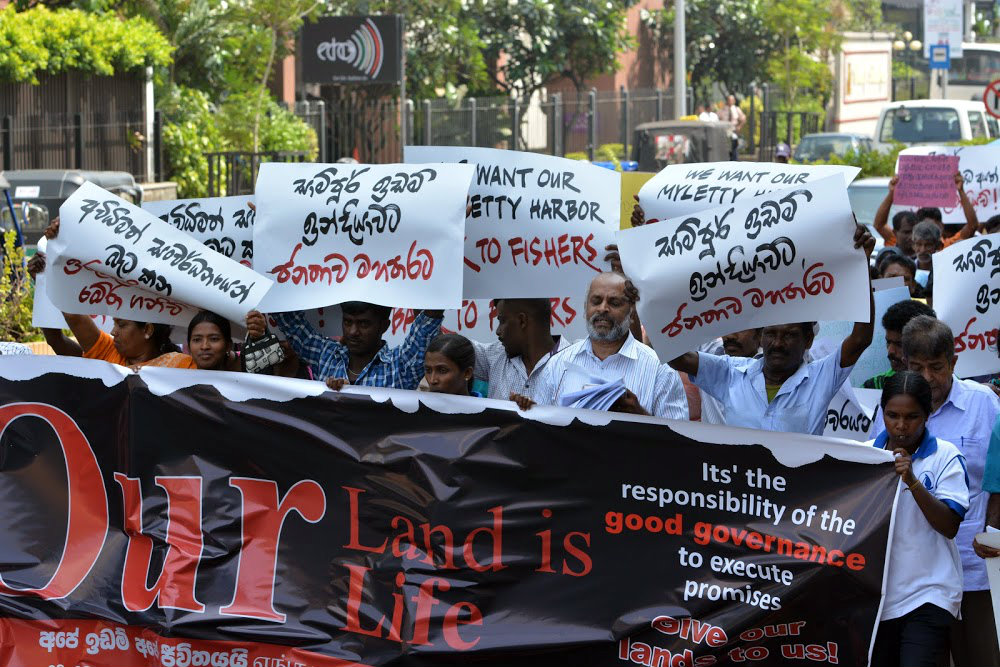Our Land is Our Life: Recently Resettled Sri Lankans Find Themselves in a Struggle for Land Rights Again
By Herman Kumara, Praja Abhilasha, Joining Hands Sri Lanka
March 7, 2016

Mullikulam, a displaced person at Our Land is Our Life demonstration on February 11, 2016 in Colombo, Sri Lanka. Photo Credit: Courtesy of Praja Abhilasha.
The newly elected government (Jan 2015) of Matripala Sirisena announced on February 11, 2015, that it would release the 1200 acres of land in Sampur, Sri Lanka, to internally displaced persons (IDPs) who had been evicted by the military in 2006, during the civil war. After the eviction, the government had declared the area a ‘high security zone’ with the objective of developing it into a special economic zone (SEZ), a zone usually set up to encourage business development and foreign direct investment.
For the 1800 people evicted, mostly farmers and fisherman, the land and its waters had been their livelihood. So far, 322 families out of the 1800 IDPs were able to resettle their land back. Others remain in refugee camps or have been lost in the transition.
The Navy Training Center which was built when the land was declared a “high security zone” remains. A new thermal power plant is under construction by the Indian company National Thermal Power Corporation. The SEZ status of the land has not yet been lifted as people resettle the land. Now, a year later and there hasn’t been much progress made. IDPs are losing patience; some have even taken their lands back forcefully without government support.
Now, 18 resettled families are faced with another displacement issue. They have been asked by the government to vacate their resettled lands because they are living on land needed for the thermal power plant. The thermal power plant requires a 20 meter wide by 8 kilometers long tunnel for the discharge of waste water. These 18 families have been identified as living within the path of the tunnel.
However, the problem is not only an issue of displacement; there is now an added environmental problem. The waste water that the plant will discharge risks polluting the sea and endangering the flora and fauna.

Herman Kumara, Chair of Praja Abhilasha marches with hundreds at the “Our Land Our Life” protest. Photo Credit: Courtesy of Praja Abhilasha.
“We do not want to see our sea to be polluted by this discharge of waste water from the Power Plant. Our main occupation is fishing. Any damage to the sea will have negative implications for our livelihood. We do not want to construct the thermal power plant in our area,” says Krishnapillai, the leader of the Sampur displaced community.
Krishnapillai states further, “We do not want the Navy Training Center and the Thermal Power Plant in our lands; the displaced communities must be resettled”.
Today, we the people of Sri Lanka are witnessing broken promises. In Sampur, Paanama, Valikamam North, and in many other areas of Sri Lanka, we find people languishing in IDP camps and clamoring to be resettled on their own lands.
The struggle continues and the people will fight till they are resettled on their own lands. Praja Abhilasha (PA), the Joining Hands network in Sri Lanka, in partnership with the National Fisheries Solidarity Movement (NAFSO) and the People’s Alliance for Right to Land (PARL), are mobilizing communities to reach their goals for resettlement and sustain their hope.
We continue our commitment to work for people’s right to live with dignity and freedom and earn a livelihood. We hear the echo of this commitment in the words of Krishnapillai - “Our land is our life.”

